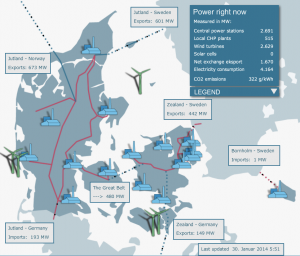“Why make it complicated when it is simple” might be the motto of Energinet.dk – the Danish Transmission System Operator, at least when it come to explain the fundamentals regarding integration of variable renewable energy. But of course the have the experience, with 55% of the electricity consumption in December 2013 delivered by wind power.
At the IRENA assembly in Abu Dhabi, Peter Jørgensen, Vice President for International Relations, gave a short, but very clear presentation of the challenges, means and the preconditions for a successful grid-integration.
Challenges
The main challenges for variable RE compared to conventional power production is how to develop the energy system to maximize the value of the generation as it come. The characteristics for these RE technologies – the variability of the renewable resources, the location of the energy production – which might be far from load centres or as household connector photovoltaic, and the cost structure with large upfront investments and almost zero marginal energy costs – stresses the “old” energy system and the “old” thinking about how to run the power system and power markets.
Means
In order to solve this challenge, focus should be on grid development and flexibility measures. Peter Jørgensen underlined at the presentation the fact, that investments in transmission lines are much cheaper than investments in power generation, and strong transmission grids will be able to balance RE sources in larger areas. Furthermore competitive electricity markets are necessary to ensure optimal utilization of the transmissions grid in a flexible way.
The flexibility measures includes grid codes to ensure stability, and clear price signals reflecting the system balance to incentivize dynamic response. The SmartGrid concept should be replaced by SmartEnergy to optimize RE utilization across energy sector and support price flexibility. Last but least, new operational procedures and forecasting tools are needed to ensure efficient system balancing and security of supply.
Preconditions
To make this happen, a political commitment and regulatory framework is a prerequisite, together with long term grid planning and a similar coherent energy system planning to ensure the optimal use of RE in all sectors. And a new paradigm for system operation is a must, ensuring the right price mechanisms for flexibility in generation and demand, and ensuring a dynamic and efficient system balancing and security of supply
Ok, implementation of means and preconditions might not be simple but a clear picture of what is needed and why, must be the starting point. And I think that Energinet’s presentation hit the nail here!
See the Energinet.dk presentation here.

